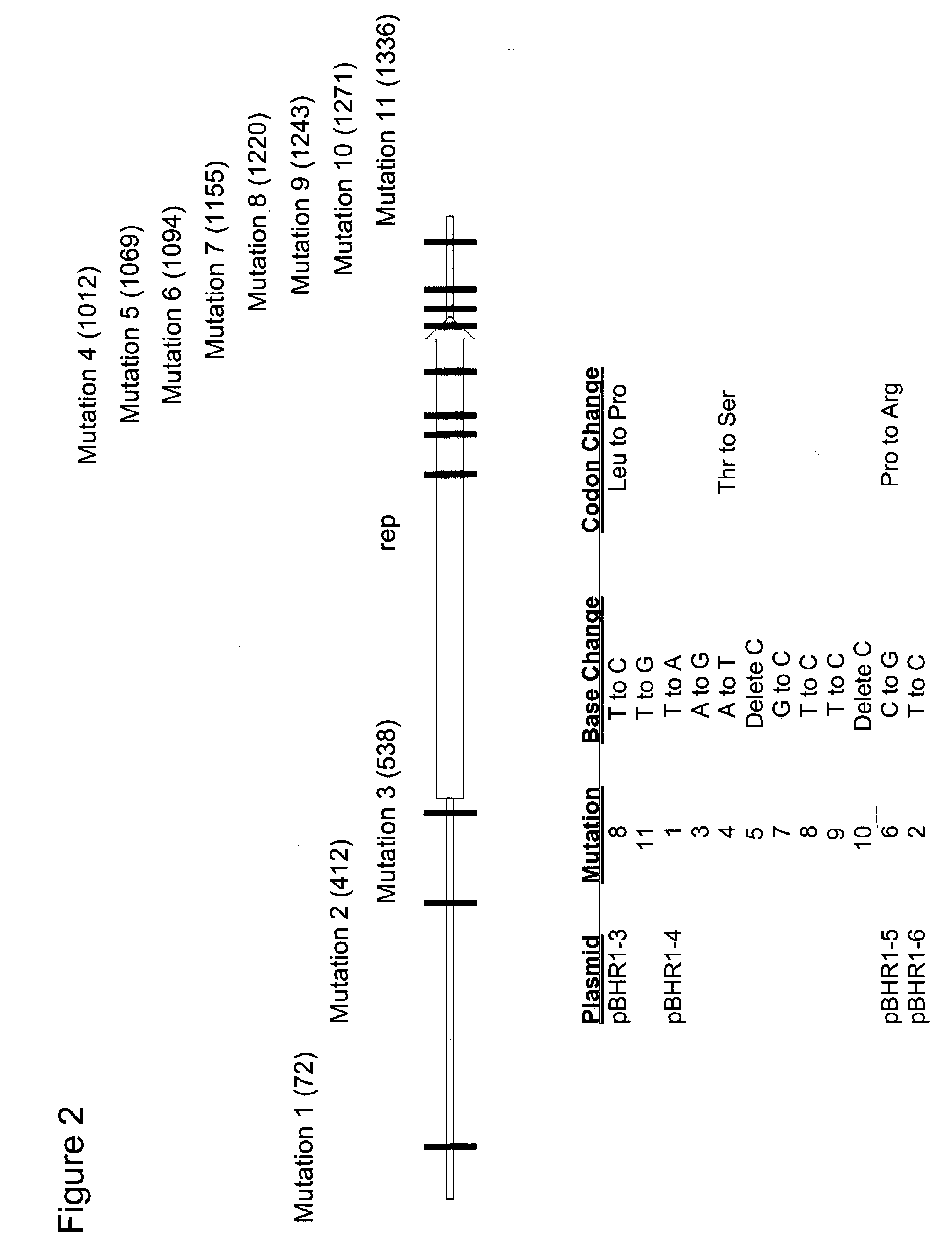Temperature sensitive mutant derivatives of the broad host range plasmid pBHR1
a broad host range, temperature sensitive technology, applied in the field of molecular biology and cloning vectors, can solve the problems of not all plasmids are inherently useful, the utility and need for the development of ts-pbhr1 plasmids has not been previously recognized, and it is impossible to predict which mutations in the replication control region of pbhr1 will encode temperature sensitive mutations, etc., to achieve efficient modification of host genetic traits in a short tim
- Summary
- Abstract
- Description
- Claims
- Application Information
AI Technical Summary
Benefits of technology
Problems solved by technology
Method used
Image
Examples
example 1
Isolation of Mutant Derivatives of Plasmid pBHR1 that are Temperature Sensitive for Replication
[0207]This example describes how error prone PCR was used to induce mutations in plasmid pBHR1 that cause plasmid replication to be temperature sensitive. The rep gene was amplified by error prone PCR from pBHR1. The resulting PCR product was ligated to a restriction fragment derived from pBHR1 so that the original rep gene was replaced by the product of error prone PCR. Several mutant plasmids were identified that could be maintained in E. coli when grown at 30° C. but were lost from E. coli host cells grown at 42° C. in the absence of antibiotic selection. Sequence analysis indicated that each mutant plasmid had one or more mutations in or near the pBHR1 rep gene.
Error Prone PCR and Ligation of Product to pBHR1 Vector Backbone
[0208]Primers PBHR1LEFT1 (SEQ ID NO:7) and PBHR1RIGHT1 (SEQ ID NO:8) were used in a series of 100 μl error prone PCR reactions to amplify a 1,650 bp fragment from p...
example 2
Sequence of the Ts Replication Control Region in Mutant Derivatives of Plasmid pBHR1
[0216]This example describes the sequence of the region that was subjected to error prone PCR for each temperature sensitive replication mutant derived from pBHR1, as described in Example 1. Plasmids pBHR1–5 and pBHR1–6 each had a single different base pair change. Plasmids pBHR1–3 and pBHR1–4 each had multiple base pair changes.
[0217]Primers PBHR1LEFT1 (SEQ ID NO:7) and PBHR1RIGHT1 (SEQ gID No:8) were used to amplify a 1,650 bp fragment from each of the pBHR1 derivatives listed in Table 1 that contained the pBHR1 rep gene (FIG. 1). The PCR products were sequenced on an automated ABI sequencer (Applied Biosystems, Foster City, Calif.). The sequencing reactions were initiated with PBHR1LEFT1, PBHR1LEFT2 (SEQ ID No:9), PBHR1LEFT3 (SEQ ID No:10), PBHR1RIGHT1, PBHR1RIGHT2 (SEQ ID No:11) and PBHR1RIGHT3 (SEQ ID No:12). The resulting sequences were assembled using ContigExpress which is a component of Vect...
PUM
| Property | Measurement | Unit |
|---|---|---|
| restrictive temperature | aaaaa | aaaaa |
| restrictive temperature | aaaaa | aaaaa |
| restrictive temperature | aaaaa | aaaaa |
Abstract
Description
Claims
Application Information
 Login to View More
Login to View More - R&D
- Intellectual Property
- Life Sciences
- Materials
- Tech Scout
- Unparalleled Data Quality
- Higher Quality Content
- 60% Fewer Hallucinations
Browse by: Latest US Patents, China's latest patents, Technical Efficacy Thesaurus, Application Domain, Technology Topic, Popular Technical Reports.
© 2025 PatSnap. All rights reserved.Legal|Privacy policy|Modern Slavery Act Transparency Statement|Sitemap|About US| Contact US: help@patsnap.com


